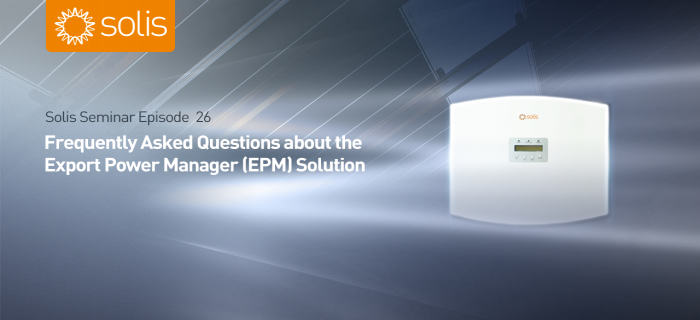
Solis Seminar Episode 26?Frequently Asked Questions about the Export Power Manager (EPM) Solution
Background
The Solis EPM accessory, as an energy control device, has an enormously powerful function. In addition to controlling the energy output of the PV system, it can also be used as a reactive power adjustment and power factor compensation device. During installation we hear common questions being asked so in this episode of Solis Seminar we’ve collated the most frequently asked questions and answered them for you.
Frequently Asked Questions
1) What is the difference between the EPM models available; EPM1-5G, EPM3-5G, EPM3-5G-PLUS?
Answer:
EPM1-5G
This is suitable for 220V/230V single-phase systems, can be used across different inverter models, and can control up to 10 inverters.
EPM3-5G
This is suitable for three-phase, three-wire systems, 220VAC, 380/400VAC, 480VAC voltage, can be used across different inverter models, can control up to 10 inverters and is suitable for three-phase Delta grids with no neutral.
EPM3-5G-PLUS
This is suitable for three-phase, four-wire systems, 220VAC, 380/400VAC voltage, can be used across different inverter models and the maximum theoretical quantity of inverters it can control is 80. This does not support grids with no neutral.
2) Why is the power not being controlled or being controlled incorrectly?
Answer:
This may be caused by the following reasons:
1. The number of inverters and system capacity settings do not reflect the actual situation. Follow the steps below to confirm and correct;
- Advantage setting→InverterQty.set→Set INV NUM?(01-99)
- Advantage setting→Set EPM regulator→Capacitysetting→setcapa: xxxx W
2. The primary current of the CT is smaller than the actual current of the grid connection point, causing damage to the CT. See the diagram below.
3. The selected secondary current of the CT is not 5A. The Solis 5G series EPM box requires a CT with a secondary current of 5A. If it is 200mA or 1A, inaccurate power detection of the grid may lead to issues with the EPM.
4. The CT installation position in relation to the EPM Box is incorrect. If it is installed on the load branch circuit, abnormal power control can occur. See the diagram below.
3) Why is the grid power shown by the EPM different to the meter reading?
Answer:
When this problem occurs, the following factors should be considered?
1. Check the CT current ratio setting of the EPM reflects the actual PV system specifications
Advantage setting→Set CT Ratio→Set Para?
2. Confirm whether the secondary current of the CT is 5A
3. Use a clamp meter to measure the current at the CT and compare it with the current displayed by the EPM-Information to determine whether the CT or the EPM itself is faulty
4. Check whether the grid voltage displayed by the EPM-Information has an abnormal value
4) What does the “CT fail-safe” alarm mean?
Answer
This is usually caused by a connection failure between the CT and the EPM. The following action can be taken to troubleshoot:
- CT fail-safe means that the EPM box detects that the CT is not connected. You should check the wiring between the CT and the EPM box or use the current value of each phase of the EPM-Information to determine which CT is causing the error message
- Note: When this fault occurs, all installed inverters will also display a "Failsafe" alarm message. If this message does not appear it means that the inverter's "failsafe" option is switched off.
5) "RS485 Fail" or "RS485 AllFail" alarm is displayed on the EPM box
Answer
“RS485 Fail”
This indicates that the RS485 communication between the inverter and the EPM Box in the entire system is faulty. You should check the connection between each inverter and the RS485 bus;
Use a multi-meter to measure the voltage between the A pin and B pin of each inverter's RS485 communication port which under normal operation should read about 1.6V. If there is a large deviation from this, it indicates that the inverter's communication terminal could be faulty.You should also check whether the number of inverter settings on the EPM and the inverter's slave address settings are correct.
“RS485 ALLFail”
This indicates that the RS485 communication between all inverters and the EPM is faulty.
You should check the connection between the RS485 bus and the EPM by doing the following:
? Unplug the RS485 bus connector and use a multimeter to measure the voltage between the A pin and the B pin, which in normal state should read about 1.6V. If there is a large deviation from this, the A pin and B pin of the RS485 terminal on the inverter side may be reversed.
? If there are intermittent "fail-safe" problems, it may be caused by on-site interference. If this is the case, it is recommended that you upgrade to a higher quality, shielded RS485 cable.

.gif)
.jpeg)
leave your comment